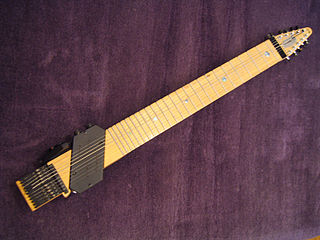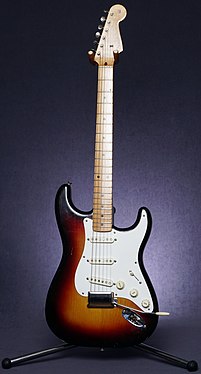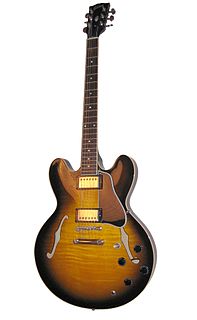
The bass guitar is a stringed instrument similar in appearance and construction to an electric guitar, except with a longer neck and scale length, and four to six strings or courses.

An electric guitar is a guitar that uses one or more pickups to convert the vibration of its strings into electrical signals. The vibration occurs when a guitar player strums, plucks, fingerpicks, slaps or taps the strings. The pickup generally uses electromagnetic induction to create this signal, which being relatively weak is fed into a guitar amplifier before being sent to the speaker(s), which converts it into audible sound.

The guitar is a fretted musical instrument that usually has six strings. It is typically played with both hands by strumming or plucking the strings with either a guitar pick or the finger(s)/fingernails of one hand, while simultaneously fretting with the fingers of the other hand. The sound of the vibrating strings is projected either acoustically, by means of the hollow chamber of the guitar, or through an electrical amplifier and a speaker.

Rickenbacker International Corporation is an electric string instrument manufacturer based in Santa Ana, California. The company is credited as the first known maker of electric guitars—in 1932—and eventually produced a range of electric guitars and bass guitars. Known for their distinctive jangle and chime, Rickenbacker twelve string guitars were favored by the Beatles and Gerry Marsden of Gerry and the Pacemakers. Well known players of the six string include John Fogerty of Creedence Clearwater Revival.

Vox is a musical equipment manufacturer founded in 1957 by Thomas Walter Jennings in Dartford, Kent, England. The company is most famous for making the Vox AC30 guitar amplifier, used by The Beatles, The Rolling Stones, The Kinks, The Yardbirds, Queen, Dire Straits, U2 and Radiohead, the Vox Continental electric organ, the Vox wah-wah pedal used by Jimi Hendrix, and a series of innovative electric guitars and bass guitars. Since 1992, Vox has been owned by the Japanese electronics firm Korg.

The Chapman Stick is an electric musical instrument devised by Emmett Chapman in the early 1970s. A member of the guitar family, the Chapman Stick usually has ten or twelve individually tuned strings and has been used on music recordings to play bass lines, melody lines, chords, or textures. Designed as a fully polyphonic chordal instrument, it can also cover several of these musical parts simultaneously.

An instrument amplifier is an electronic device that converts the often barely audible or purely electronic signal of a musical instrument into a larger electronic signal to feed to a loudspeaker. An instrument amplifier is used with musical instruments such as an electric guitar, an electric bass, electric organ, synthesizers and drum machine to convert the signal from the pickup or other sound source into an electronic signal that has enough power, due to being routed through a power amplifier, capable of driving one or more loudspeaker that can be heard by the performers and audience.

A guitar amplifier is an electronic device or system that strengthens the weak electrical signal from a pickup on an electric guitar, bass guitar, or acoustic guitar so that it can produce sound through one or more loudspeakers, which are typically housed in a wooden cabinet. A guitar amplifier may be a standalone wood or metal cabinet that contains only the power amplifier circuits, requiring the use of a separate speaker cabinet–or it may be a "combo" amplifier, which contains both the amplifier and one or more speakers in a wooden cabinet. There is a wide range of sizes and power ratings for guitar amplifiers, from small, lightweight "practice amplifiers" with a single 6" speaker and a 10 watt amp to heavy combo amps with four 10” or four 12" speakers and a powerful 100 watt amplifier, which are loud enough to use in a nightclub or bar performance.

The Fender Stratocaster is a model of electric guitar designed in 1954 by Leo Fender, Bill Carson, George Fullerton, and Freddie Tavares. The Fender Musical Instruments Corporation has continuously manufactured the Stratocaster from 1954 to the present. It is a double-cutaway guitar, with an extended top "horn" shape for balance. Along with the Gibson Les Paul and Fender Telecaster, it is one of the most-often emulated electric guitar shapes. "Stratocaster" and "Strat" are trademark terms belonging to Fender. Guitars that duplicate the Stratocaster by other manufacturers are usually called S-Type or ST-type guitars.

A semi-acoustic guitar or hollow-body electric is a type of electric guitar that originates from the 1930s. It has both a sound box and one or more electric pickups. This is not the same as an acoustic-electric guitar, which is an acoustic guitar with the addition of pickups or other means of amplification, added by either the manufacturer or the player.

The Jazz Bass is the second model of electric bass created by Leo Fender. It is distinct from the Precision Bass in that its tone is brighter and richer in the midrange and treble with less emphasis on the fundamental frequency. It has a more focused tone than the Precision Bass, with less low end and low midrange. The sound of the Jazz Bass has been fundamental in the development of signature sounds in certain musical genres, such as funk, disco, reggae, blues, progressive rock, heavy metal and jazz fusion.

The Fender Mustang is a solid body electric guitar produced by the Fender Musical Instruments Corporation. It was introduced in 1964 as the basis of a major redesign of Fender's student models, the Musicmaster and Duo-Sonic. It was produced until 1982 and reissued in 1990.

Vox bass guitar is any of the bass guitars made by Vox, a British musical equipment company, in the 1960s. Vox made a number of bass guitars during the 1960s, although they were not nearly as successful as their efforts in amplifiers.

Kramer Guitars is an American manufacturer of electric guitars and basses. Kramer produced aluminum-necked electric guitars and basses in the 1970s and wooden-necked guitars catering to hard rock and heavy metal musicians in the 1980s; Kramer is currently a division of Gibson Guitar Corporation.
A solid-body musical instrument is a string instrument such as a guitar, bass or violin built without its normal sound box and relying on an electromagnetic pickup system to directly receive the vibrations of the strings.
Electric guitar design is a type of industrial design where the looks and efficiency of the shape as well as the acoustical aspects of the guitar are important factors. In the past many guitars have been designed with all kinds of odd shapes as well as very practical and convenient solutions to improve the usability of the object.

Kalamazoo is the name for two different lines of instruments produced by Gibson. In both cases Kalamazoo was a budget brand. The first consisted of such instruments as archtop, flat top and lap steel guitars, banjos, and mandolins made between 1933 and 1942, and the second, from 1965 to 1970, had solid-body electric and bass guitars.
Ritz Guitar Co. produced guitars in 1988 and 1989 over an 8-month period in Southern California in Wayne Charvel's workshop in Ontario. The company became known quality based upon Wayne's notoriety and for their amazing cracked shell mosaic finishes on their 'Neptune' series which was originally patented, designed and built by Andy Soler. Each little piece of shell was hand-cracked and stuck on the guitar body by hand. Introduced to Andy Soler's nephew Eric Galletta and eventually produced by Wayne Charvel, Andy Soler and Eric Galletta with Ritz being financially backed and majority owned co founders Brad Becnel's Sunset Ladders of South El Monte, CA and Cliff Wildes of East Haven Conn, they made around 150 guitars with only about 25 being the cracked shell 'Neptune' models. The first two collectable models were handmade by Wayne Charvel in Gold Abalone and gold plated hardware for Cliff Wildes and a White Abalone for Brad Becnel, both featured in Ritz magazine ads. The other models were the 'Exotic' series, which used rare woods and kept them as a natural finish, there was a one off 'Exotic' model made from small pieces of rare woods stuck together like a mosaic to form the body of the guitar, in a similar idea to the shell finished 'Neptune' series. The lower cost 'Classic' Series had painted or Zolatone finishes with Wayne Charvel making his first ever 1 of a kind Midi guitar in corvette red for Wildes. All body shapes were Strat style, however, there is a rumor that a V shaped Ritz Neptune exists. The examples of shell types available were; Violet Oyster, Brown Lip, Black Lip, Green Shell, Abalone Shell, Nautilus Shell, and Snake Lip. Most Ritz Neptunes had Alder bodies for their light weight and some with Maple or Bubinga bodies under the shell finish. They mainly used Seymour Duncan, PAF (pickup) or Schaller Guitarenparts pickups. All came with the Kahler Tremolo System Spyder model. The guitars retailed for over $2000.00. Most of the later Ritz guitars featured Warmoth Guitars necks made for Ritz as Ritz were running out of money and time to make their own. These necks were thinner than the Ritz made necks but still very good. The Warmoth logo can be located at the join on the on these necks if you take them off. Also a few Ritz Guitars were made after the demise of the company in 1991. This is thought to be because Wayne Charvel had a few Ritz necks left over and he attached them to one off custom orders at a little less money. A great book to read by the man himself Wayne Charvel is “The Custom Guitar Shop” which includes the Ritz story.

Guitar manufacturing is the use of machines, tools, and labor in the production of electric and acoustic guitars. This phrase may be in reference to handcrafting guitars using traditional methods or assembly line production in large quantities using modern methods. Guitar manufacturing can also be broken into several categories such as body manufacturing and neck manufacturing, among others. Guitar manufacturing includes the production of alto, classical, tenor, and bass tuned guitars.
The Fender Telecaster, colloquially known as the Tele, is the world's first commercially successful solid-body electric guitar. Its simple yet effective design and revolutionary sound broke ground and set trends in electric guitar manufacturing and popular music. Introduced for national distribution as the Broadcaster in the autumn of 1950, it was the first guitar of its kind manufactured on a substantial scale and has been in continuous production in one form or another since its first incarnation.




















